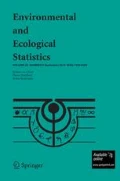Abstract
Data collection for fresh-water regions of The Ecosystem Health Monitoring Program (EHMP), in southeast Queensland, Australia, involves the sampling of over 130 sites among 19 catchments twice per year and has been ongoing for over ten years. The sampling design was derived following an exhaustive process of indicator and site selection to develop a composite indicator that represented aquatic ecosystem health. After 13 years of implementation, there was an interest in identifying redundancies in sampling to reduce sampling costs without making a substantial impact on the integrity of the program and its capacity to report on ecosystem health. This paper focuses on identifying a subset of sites and times that could be removed from sampling with a minimal impact on the subsequent ecosystem health scores. Herein, Mixed models are employed to assess a variance structure from which optimality criteria are utilized to identify the scheme. Integer programs are then used to ensure specific practical constraints are observed.




Similar content being viewed by others
References
Beyer HL, Watts ME (2016) Solving conservation planning problems with integer linear programming. Ecological Modelling 328:14–22
Bunn S, Abal E, Smith M, Choy S, Fellows C, Harch B, Kennard M, f. Sheldon, (2010) Healthy Waterways, Healthy Catchments: Making the Connection in South East Queensland, Moreton Bay and Catchments Partnership, Brisbane Queensland, 222 p. Ecological Applications 55:223–240
Clarke PG, Stefanova KT (2011) Optimal design for early-generation plant-breeding trials with unreplicated or partially replicated test lines. Australian and New Zealand Journal of Statistics 53:461–480
Csuti B, Polasky S, Williams PH (1997) A comparison of reserve selection algorithms using data on terrestrial vertebrates in Oregon. Biological Conservation 80:83–97
Greene WH (1994) Econometric Analysis. Prentice Hall, Upper Saddle River NJ
Kiefer J (1974) General Equivalence Theory for Optimum Designs (Approximate Theory). Annals of Statistics 2:849–879
Martin R (1986) On the Design of Experiments Under Spatial Correlation. Biometrika 73:247–277
McCulloch CE, Searle SR (2001) Generalized, Linear, and Mixed Models. Wiley, New York
Moilanen A (2008) Two paths to a suboptimal solution - once more about optimality in reserve selection. Biological Conservation 141:1919–1923
Pressey RL, Possingham HP, Margules CR (1996) Optimality in reserve selection algorithms: When does it matter and how much? Biological Conservation 76:259–267
Schmelter T (2007) The optimality of single-group designs for certain mixed models. Metrika 65:183–193
Sebolai B, Pedersen J, Marx D, Boykin D (2005) Effect of control plot density, control plot arrangement, and assumption of random or fixed effects on nonreplicated experiments for germplasm screening using spatial models. Crop Science 45:1978–1984
Sheldon F, Peterson EE, Boone EL, Sippel S, Bunn SE, Harch BD (2012) Identifying the spatial scale of land use that most strongly influences overall river ecosystem health score. Ecological Applications 22:2188–2203
Stewart-Koster B, Boone EL, Sheldon F (2014) Statistical Investigation for Optimisation of the Healthy Waterways, Ecosystem Health Monitoring Program (EHMP)
Vanderkam RPD, Wiersma YF, King DJ (2007) Heuristic algorithms vs. linear programs for designing efficient conservation reserve networks: Evaluation of solution optimality and processing time. Biological Conservation 137:349–358
Funding
Not applicable.
Author information
Authors and Affiliations
Corresponding author
Ethics declarations
Conflict of interest
The authors declare that they have no conflict of interest.
Additional information
Communicated by Luiz Duczmal.
Appendix
Appendix
1.1 Annual/seasonal score components
Specific data collected at freshwater sites:
-
1.
pH, Cond, Temp and DO are averaged to obtain the Water Quality Indicator,
-
2.
DelC, R24 and GPP are averaged to form the Ecosystem Process indicator,
-
3.
MacroRich, PET, and SIGNAL are averaged to form the Macroinvertebrate indicator,
-
4.
PONSE, FishOE and PropAlien are averaged to form the Fish indicator, and
-
5.
The index DelN by itself forms the Nutrient indicator.
1.2 Matrix model notation for mixed models
Section 2.3 introduces the matrix notation in Eq. 3 for Model (2) described in Sect. 2.2. This section illustrates the explicit components of the \(\mathbf{y }\), \(\mathbf{X }\), \({\varvec{\beta }}\), \(\mathbf{U }\), \({\varvec{\delta }}\), and \({\varvec{\varepsilon }}\), matrices and vectors in Eq. 3 in relation to the scalar notation and indices contained in both of Sects. 2.2 and 2.3. Based on Indices (1) and Model (2), let
denote the \(r_i \times 1\) vectors for the score y and error terms \(\varepsilon \) for site i at times \(t_i,\ldots ,T_i\) for \(r_i\) adjacent and evenly spaced time points. Then the \(N \times 1\) vectors \(\mathbf{y }\) and \({\varvec{\varepsilon }}\) displayed in Eq. (3) for sites \(i=1,\ldots ,n\) are defined as
The random effects and regressor coefficients, respectively, are denoted as
If we denote the \(r_i \times p\) regressor matrix for site i as \(\mathbf{x }_i\), then the full regressor matrix \(\mathbf{X }\) in Eq. (3) is represented by the vertical concatenation of these matrices:
Finally, the \(\mathbf{U }_{N \times n}\) matrix consists of 0/1 entries based on whether or not observation \(y_{ij}\) is observed in site i. If we denote an \(r_i \times n\) matrix \(\mathbf{u }_i\) for site i as a matrix with the ith column equal to unity and all other entries equal to zero, then the \(\mathbf{U }\) matrix is represented by the vertical concatenation of these matrices:
1.3 General covariance matrix for y
Consider \(r_i \equiv T_i -t_i + 1\), and \(N = \sum _{i=1}^{n} r_i\) for sites \(i=1,\ldots ,n\) with the matrix \({\mathbf {J}}\) and matrices \(R_i\) of dimension \(r_i \times r_i\) defined as in Sect. 2.2. Then the resulting covariance matrix is expressed as
Rights and permissions
About this article
Cite this article
Hays, S., Kumari, B., Stewart-Koster, B. et al. Site reduction in redundant ecosystem sampling schemes. Environ Ecol Stat 28, 567–586 (2021). https://doi.org/10.1007/s10651-021-00502-7
Received:
Revised:
Accepted:
Published:
Issue Date:
DOI: https://doi.org/10.1007/s10651-021-00502-7




